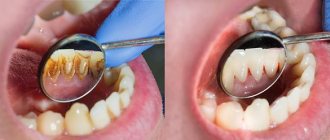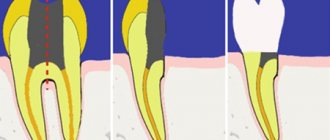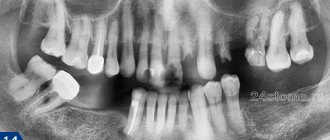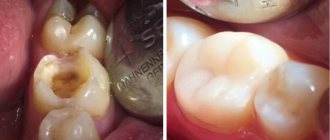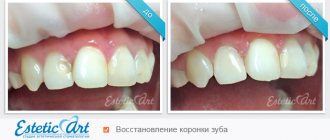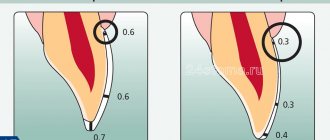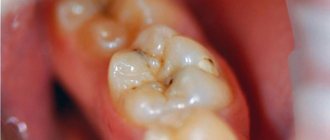Author of the article:
Soldatova Lyudmila Nikolaevna
Candidate of Medical Sciences, Professor of the Department of Clinical Dentistry of the St. Petersburg Medical and Social Institute, Chief Physician of the Alfa-Dent Dental Clinic, St. Petersburg
Whitening a pulpless tooth differs significantly from the procedure performed on healthy teeth. In the usual sense, the creation of a snow-white smile occurs with the help of a special gel, where the active substance is hydrogen peroxide in various concentrations. The composition is applied to the surface of the enamel and left for some time. In this case, additional activators can be used - laser, ultraviolet, cold light from a LED lamp, and so on. All this is necessary for oxygen to begin to be released from the gel, which discolors the yellow pigment.
Whitening a dead tooth is also done using hydrogen peroxide, but the procedure itself is radically different. Let's figure out why it is needed and how the treatment works.
Nerve function and reasons for its removal
Dental nerve endings perform several functions: they respond to external stimuli (cold, hot, spicy, sour) and protect elements from pathogenic microorganisms. It is believed that teeth lacking pulp are more vulnerable to caries and other destructive processes.
Often, elements devoid of nerves may also differ in shade from healthy teeth, since they tend to darken. Because of this, the pulpless elements are called “dead” in another way. This process is due to the fact that the tooth is deprived of blood supply and does not receive the necessary minerals from the body.
It is worth considering in more detail the situations in which dentists recommend resorting to tearing out the tooth pulp and subsequently filling it with composite materials. In mild forms of caries, only the upper part of the tooth – enamel and dentin – is affected. In this case, doctors remove the damaged layers of the tooth without affecting its nerve endings. In advanced forms of the disease, the nerve endings of the tooth (pulp) may be damaged; in this case, dentists remove the tissue completely or only part of it.
The indication for depulpation is periodontitis. In this case, it is impossible to restore the health of the tooth without removing the nerve endings in it. Inflammation of the pulp is also possible if the dentist did not properly clean the dentinal tubules of the tooth or made mistakes when filling it. This type of problem in dentistry is called “drug-induced pulpitis.”
Other indications for depulpation include:
- extensive tooth destruction (more than 2/3 of the crown);
- prolonged aching pain in the element;
- the presence of stones in the root canals of the tooth;
- chipping or damage to the bone tissue of the elements as a result of consumption of hard foods or any trauma.
Nerve endings can also be removed in those elements that appear healthy. Pathological processes do not always begin in the visible part; in some cases, caries and inflammatory processes are localized in the deep layers, under the crown.
Stages of intracanal bleaching
An important point in the intracanal bleaching procedure is examination and correct diagnosis. A dentist at the LeaderStom clinic can prescribe endobleaching only after a thorough examination and X-ray examination. In this matter, you need to understand how correctly and hermetically the canals of the organ are sealed, whether there are signs of inflammation of the periodontal tissues, and whether secondary caries is developing inside the crown cavity. If ambiguous information is received during diagnosis, dental therapists from the Leaderstom clinic network can use the latest Karl Kaps microscope. This equipment allows you to examine intracanal tooth tissues with maximum accuracy and high resolution.
When your doctor is sure that the tooth has no contraindications for whitening, you can begin the lightening procedure. To do this, the old filling is removed, and a glass ionomer gasket is placed at the entrance of the root canals. It prevents hydrogen peroxide from entering the root canal area. Then a bleaching solution, which may have varying concentrations of hydrogen peroxide, is introduced into the cavity. After two weeks, this procedure is repeated if necessary.
When the whitening result is achieved, the dentist moves on to the stage of composite restoration of the dental crown.
Characteristics of a pulpless tooth
The first problem that people encounter after depulpation is the fragility of the element. After the intervention, it is not recommended to chew hard and rough food on the problematic side, as this may cause breakage of the segment. After depulpation, many doctors advise patients to resort to restoring the problem unit using crowns or prosthetics. After restoration, it will be possible to preserve the integrity of the “dead” element for many years. With successful treatment and restoration, the tooth can last more than 10 years. Otherwise, the “dead” element will collapse within 1–2 years.
The service life of a pulpless unit largely depends on the quality of the dental canal filling by the dentist. Mistakes made by the doctor during the procedure can lead to various complications: dental cyst, fistula or gumboil. In this case, the unit cannot be saved. In order to minimize the risk of unpleasant consequences, the doctor must follow a clear algorithm for performing work to remove nerve endings. The patient, in turn, must regularly carry out hygiene measures (2 times a day) and visit the dentist at least once every 6 months.
Care for whitened teeth
A discolored dental crown is no longer as hard and secure as a healthy tooth. Therefore, you should treat the organ with care while chewing. Do not neglect the rules of daily hygiene. You need to brush your teeth twice a day, with a toothbrush and toothpaste without abrasives. Use dental floss and special rinses regularly.
The intracanal bleaching procedure requires high professionalism of doctors and the use of the latest generation chemicals. The extensive experience of our dentists allows us to carry out endobleaching with maximum preservation of healthy tissues of the dental crown, as well as achieving a lasting, noticeable result. By ordering this procedure, our patients can receive discounts and bonuses on services such as ultrasonic teeth cleaning or Air Flow hardware cleaning. Sign up for a free consultation and receive quality teeth whitening services.
Problems arising after depulpation
The first problem that patients encounter after removing the nerve from the problematic element is blackening of the enamel, which is a serious aesthetic defect. The reasons for crown darkening include the following factors:
- improperly performed dental work;
- insufficient intake of microelements;
- the use of dental instruments containing silver or resorcinol - formaldehyde during the intervention;
- damage to the blood vessels of the element and further disruption of blood supply.
A tooth that has turned black after depulpation.
Another problem after the intervention, which is often noted by patients in dental clinics, is pain in a tooth without a nerve. Discomfort may occur when pressing on the unit, tapping on it, or biting into food. The opinion that a “dead” tooth cannot hurt is considered erroneous. The cause of discomfort may be previous illiterate treatment, inflammation of periodontal tissue, etc. In such cases, the patient should immediately consult a doctor in order to identify the cause of the problem.
In a normal state, the “dead” element continues for another 7–10 days after depulpation. Sometimes the cause of discomfort is not the unit that has lost its nerve endings, but the healthy neighboring one. It will seem to a person that the cause of the problem is a previously treated tooth, since toothache is sometimes vague and difficult to determine its exact location. Sometimes pain is associated with damage to the gums during depulpation of elements that react to cold or hot food.
Pain immediately after dental procedures is normal. The main thing is that the intensity of the discomfort gradually decreases. Discomfort disappears, as a rule, 3 weeks after removal of the nerve endings from the tooth. An increase in pain symptoms is a sure sign of the development of infectious complications. In this case, the patient should contact a highly qualified dentist as soon as possible.
Why was the nerve removed, but the tooth hurts when pressed?
Why else can a filled tooth hurt? Some reasons for the problem include:
- Incomplete removal of nerve endings, and, as a result, preservation of their sensitivity;
- Poor quality canal filling. If the filling material is not placed tightly, pores remain in the tooth canals, in which pathogenic flora multiply over time. Bacteria destroy the tooth and the soft tissue located next to it. Which leads to pain.
- Doctor damage to the root. As a result of the error, inflammation often develops in the tissues located next to the element.
- Poor quality treatment of the tooth and its canals with antiseptic agents.
- Allergic reaction to components of composite materials.
- A cheap composite that will deteriorate over time.
- Foreign body in the tooth cavity. As a result of dental procedures, fragments or microscopic parts of instruments may remain in the dental tissues. Over time, this leads to severe pain in the jaw and the development of serious complications.
And also the “dead” unit is characterized by increased fragility. Cracks invisible to the naked eye may form on its surface. Because of them, a person feels discomfort while chewing food.
Black teeth in children
The condition of “baby” teeth in children directly depends on the general condition of the body. Color changes can be caused by:
- Disorders of the gastrointestinal tract;
- Dysbacteriosis;
- Taking certain antibiotics;
- Decreased immunity;
- Fungus;
- Calcium deficiency;
- Excess fluoride and a number of other factors.
Just like permanent teeth, caries can develop in baby teeth. If a child’s tooth is black and hurts, then the destruction process has reached the internal tissues - the pulp.
Priestley's Raid
Parents often turn to the pediatric dentist with complaints about black plaque on the teeth that forms in the gum area. Despite its rather frightening appearance, this condition is usually not dangerous. Such deposits are called Priestley's plaque. The reason for black plaque on teeth is the development of the child’s digestive system, its adaptation to “adult” food. When the process is completed, the plaque disappears. But if you find black deposits on your child’s teeth, you still need to see a dentist. Often, caries develops under such plaque. You can stop this process at the initial stage using simple and painless methods.
Lifespan of a tooth without a nerve
How long does a tooth live without a nerve? The duration of operation is influenced by several factors:
- Quality of oral care after the intervention. Typically, the dentist gives the patient a number of recommendations that he will need to adhere to for 1-2 weeks. All these recommendations are aimed at minimizing the negative consequences after pulp removal. Typically they include: avoiding solid and rough foods; temporary exclusion of coloring foods and drinks from the diet; thorough oral hygiene using brush paste and dental floss; limiting excessive physical activity.
- Food quality. Solid foods consumed immediately after the element is sealed may cause the seal to fall out. In addition, they often cause chips and cracks in the enamel of the problem unit. As mentioned earlier, the “dead” segment is more vulnerable to negative external factors.
- The effect of the treatment.
- Regularity of patient visits to dental clinics.
The patient can independently make the tooth last longer; to do this, you need to follow some rules:
- include in your diet more foods containing phosphorus, calcium and other microelements necessary for teeth;
- take vitamin complexes during the off-season;
- Avoid using whitening toothpastes;
- Avoid using hard bristle brushes.
If the sealed element is destroyed as a result of the inept actions of the doctor or the patient himself, then it will no longer be possible to restore it. The only way out of the situation in this case is to remove the “dead” tooth.
What can you do about black teeth at home?
At home, it is possible to combat the darkening of teeth only in cases where the cause is external - plaque or deposits of tobacco tar. You can try to eliminate them with a highly abrasive toothpaste. But this means:
- Ineffective if the plaque is dense and hard;
- Cannot be used continuously as abrasive particles damage tooth enamel.
We do not recommend using home teeth whitening complexes offered by sellers on the Internet. They usually contain aggressive components that, together with plaque, destroy tooth enamel.
Methods for restoring the aesthetics of a pulpless unit
Darkening of tooth enamel is an aesthetic problem that not all patients can accept. Dentists offer a number of methods aimed at restoring the external characteristics of a “dead tooth.” What to do in this case? There are 3 main methods for restoring blackened enamel: endobleaching, installation of veneers and crowns. Let's consider each of the listed methods in more detail.
Endobleaching
The method involves introducing whitening agents into the upper layers of the tooth. Typically, dentists use sodium perborate for the procedure. Endo-whitening is possible not only to restore the aesthetics of a “dead” tooth, but also to lighten the enamel tone in healthy teeth.
A healthy element loses its original external characteristics due to a number of factors:
- pulp damage followed by hemorrhage;
- installation of a composite, which began to color the crown of the tooth in a pinkish tint;
- darkening of the crown as a result of silvering of the tooth.
Endobleaching is performed according to the appropriate algorithm:
- Performing professional cleaning to remove hard and soft dental plaque.
- Removing old fillings.
- Injection of a bleaching agent into the cavity of the problematic element.
- Installation of a temporary filling.
The procedure is performed every week until the tooth becomes similar in shade to the rest of the row. The minimum number of visits to the dentist is 4–5 times. The permanent composite material is installed 10 days after the last gel injection procedure.
The results of endobleaching last for an average of 2–3 years. After this time, the procedure is repeated again in cycles. Patients are not recommended to undergo more than 3 courses of whitening due to the risk of crown breakage.
This method has a number of disadvantages:
- Impossibility of predicting the result of restoration.
- The impossibility of completely restoring the enamel due to its dullness.
- There are a number of contraindications to the procedure: allergic reactions to the injected bleaching agents; pregnancy; cracks in the enamel; pathologies of the endocrine system.
Veneers
The structures are thin linings made from several types of materials - ceramics and composites. Ceramic plates are often made from zirconium dioxide or porcelain. Porcelain veneers are identical to the enamel color of healthy units. This is achieved due to the transparency of the composites used.
Composite veneers are more affordable, but their service life does not exceed 5 years. This is due to the fragility of the products and their rapid loss of their original appearance.
Installation of veneers is also carried out in stages:
- Selection of the optimal shade of the plates.
- Grinding of the top layer of enamel for better attachment of the product to the tooth. During the procedure, about 0.5–1.5 mm of enamel is ground off.
- Manufacturing of crowns on special machines using 3D technologies. Products are produced in dental laboratories using impressions previously taken from the patient’s dentition.
- Fixation of finished structures using a special adhesive.
There are contraindications for installing veneers:
- bite pathologies;
- enamel abrasion;
- high risks of dental injury;
- bruxism;
- element wobble.
The most significant disadvantage of veneers is the need to wear them throughout your life. This is due to the fact that the teeth on which the onlays are installed are subjected to preliminary grinding and can no longer be restored.
Crowns
Dentists consider this method of restoring the appearance of a “dead” tooth to be preferable. This is due to several reasons:
- Increasing the strength of a problem unit by 30–60%.
- Possibility of preserving the root during the procedure.
- Possibility of ensuring uniform load on all areas of the jaw.
- Protection of tooth tissues from external negative influences.
- The disadvantage of the procedure is the need to grind the top layer of the tooth.
All methods of restoring a “dead” tooth have a negative impact on its health. In order not to resort to the restoration procedure, it is necessary to follow a number of preventive rules. These include: timely visits to the dentist; competent choice of dental care products; daily hygiene measures; flossing after meals; high-quality cleaning of the surface of the tongue; timely change of toothbrush (once every 3 months).
